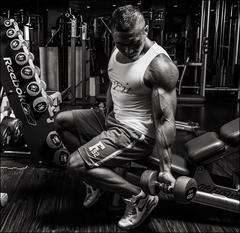High Reps for Growth

High Reps for Growth
by Chris Cormier – 1995
Most bodybuilders will tell you that you can’t get big without getting strong. If you’ve been at this sport for any length of time,, you’ve probably already learned that to get stronger and make your muscles grow, you need to lift within a rep range of 6-10. Most training articles advise you to stick with these low-rep parameters.
I’m here to tell you that the low-rep system is only second best — at least as far as leg training is concerned. You may already be using high-rep sets to train your calves, which is an endurance muscle group that actually receives a stimulus each time you take a step. Such endurance muscles respond will to high-rep training because you’re training them in a way that they were meant to be trained.
The fact is, you can train legs very heavy at low-rep ranges and make considerable progress. I did for a long time during my days as an amateur. When I was 19, I put six wheels on each side of the squat bar. In what must have been a twist of fate, I suffered an injury that changed the way I trained legs – in the long run, for the better.
One day while squatting with a relatively light weight (315 pounds), I turned just slightly to talk to someone with the bar across my shoulders; the next thing I knew, I was on my back. I felt a jolt – a pinched nerve. Instinctively, I re-racked the weight before falling to the floor, but I was unable to get up for about two hours. Though the injury was never diagnosed, it left a permanent mark: I could no longer squat in the manner I was used to without severe repercussions.
Though squatting had been my bread-and-butter leg exercise, I was forced to find an alternative that was equally effective. The movement I chose was the leg press.
The leg press may not be quite as effective as the squat in terms of overall quad development, but I can’t argue with he results I’ve experienced from using it. More important the movement itself was how I combined dong the exercise with a new training style – which brings me back to my injury.
The simple answer to my injury was to use high reps in my leg training – much higher than most people traditionally use for muscle building. No longer did I do sets of 4 to 10 reps, but rather, I pushed through 20 reps! Even though my ego occasionally craved super heavy weights, I actually found that I was growing at a far faster rate on higher reps — so much so that legs are now my number-one bodypart.
While some people might cut the weight stack in half in order to complete twice the reps, I pushed myself — enduring both physical and mental torture — to get my weights high too. How high? Turn the page if you can blow out 20 reps with 1,350 pounds. That type of training will definitely breathe fire into your quads.
How can you achieve your own heavy-weight, high-rep sets? First, attend to the physical component by warming up. With leg extensions, for instance, warm up by doing 15 reps with about 50 pounds (or whatever your warm-up weight is) for five sets. Then move on to the leg press. Start off with a couple of plates on each side of the machine for 20 reps, and add another plate on each side for every set (about five to seven total) thereafter. If you can do 15 reps with a weight, then you can do 20, but it’s best to have a spotter there to keep you moving. Add just a little more weight every workout while keeping the reps high.
Getting the muscles to do the work is hard enough, but the most difficult aspect is actually mental: the attitude that it takes to get those last few reps. That’s a champion’s greatest skill, not devising some special combination of movements but perfecting mental toughness. A champion knows what he wants, knows what he needs to do and what it takes to get it. He wants it bad enough to work through the pain.
Work on your mental approach. Keep at it. Train with others who understand its importance. A good training partner will keep you focused when you want to quit.
One last point on the leg press: I often see people doing the movement with their legs way out on the platform or alternating foot positions (ditto for calf exercises). I prefer to keep my feet shoulder-width apart, pointing directly forward or just slightly outward. I don’t think legs ware meant to do exercises with an exaggerated stance. Use a screwy stance while moving a ton of weight, and you’re just begging for an injury.
There you have it: a leg-training formula that abandons the traditional school of thought on using heavy weights and low reps to build muscle. I discovered the routine quite literally by accident — but you don’t need to, because here it is.
To view or discuss this article see the following link:
https://www.professionalmuscle.com/forums/articles-forum/17636-high-reps-growth.html
